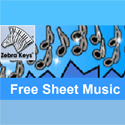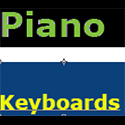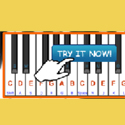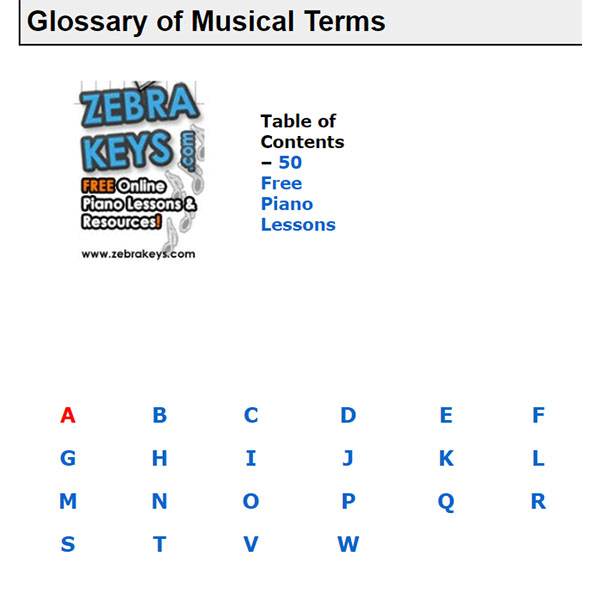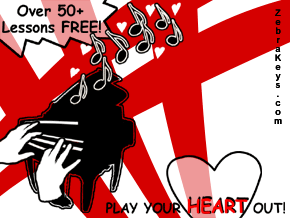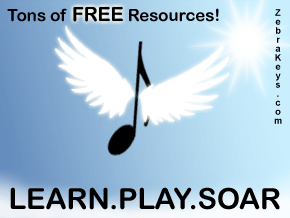Recommended
Categories
Glossary
Introduction
Welcome to the Glossary!
If you are not familiar with a musical term used on this website or any term relating to piano playing in general, Zebra Keys has searched and gathered the definitions for these musical terms. Below is a list of musical terms and definitions! If you are looking for a specific term that is not listed, you should check out this list of musical terms on Wikipedia. Also, if you are searching for a meaning to a musical symbol check out this list of modern musical symbols on Wikipedia.
| Term | Definition |
|---|---|
| 1. A Tempo - | Return to original speed |
| 2. Accent Sign (>) - | Means to play the note or notes louder |
| 3. Allegretto - | Playing the song moderately fast |
| 4. Allegro - | Playing the song fast |
| 5. Andante - | Playing the song slowly |
| 6. Arpeggio - | Chords where the notes are played in succession instead of together. |
| 7. Bar - | Organized chunk of time in music that contains a particular number of beats, usually two, three, or four beats. Another word for bar is measure. |
| 8. Bar Line - | Line used to separate bars/ measures of music. |
| 9. Bass Clef - | Musical symbol that is placed at the left side of a staff that makes a note placed on the second line from the top of the staff the F below Middle C. For this reason, it is also called the F clef. |
| 10. Chord - | Three or more notes played simultaneously |
| 11. Clef - | Musical symbol that is located at the left side of a staff that makes each line and space on the staff correspond to a specific key on the piano keyboard. In piano music, two clef signs are used, the Treble or G clef, and the Bass or F clef. |
| 12. Crescendo - | Means to play the song while gradually getting louder. |
| 13. Dampers - | Small, felt-covered pieces of wood that rest against the piano strings inside the piano. They lift when the key is struck so that when the damper returns to the string, it causes the string to cease vibrating. |
| 14. Diminuendo - | Means to play the song while gradually getting softer |
| 15. Dotted Note - | A note with a dot to the left of it. The dot next to a note adds 1/2 of that note's time duration onto itself. For example, if a half note gets 2 beats, then a dotted half note gets 3 beats. |
| 16. Dynamics - | Refers to the loudness or softness of the sounds in music. |
| 17. Eighth Note - | Note that gets an eighth of the beats of a whole note. In other words, eight eighth notes fit into one whole note. |
| 18. Flat - | Musical symbol indicating that a note should be lowered one half step or semitone. |
| 19. Forte - | Means to play the notes loudly or strongly |
| 20. Grand Staff - | Two staves that are joined together by a brace. The top staff uses the treble clef, and the bottom staff uses the bass clef. By using the grand staff, one can easily place down or see around four octaves of music notation. |
| 21. Half note - | Note that gets half the beats of a whole note. In 2/4, 3/4, and 4/4 time, the half note gets two beats. |
| 22. Harmony - | Part of a song that accompanies the main tune. Harmony can be created by playing two or more musical notes at the same time. In any song, harmony is the background musical tones that are heard which accompany the main tune or theme of a song. When listening to popular music, the strumming of a guitar or the piano parts that you hear playing alongside the singing part is harmony. |
| 23. Key - | This term can be used in many ways when talking about music. Key could refer to the actual physical key of the piano keyboard; a full sized piano keyboard contains 88 black and white keys. Key could also refer to the home base of a song. For example, if a song is in the key of C major, then the song's home base or tonal center is the C key. |
| 24. Key Signature - | A series of sharp and flat signs that appear after the clef sign that indicates which notes are to be played sharpened or flatted. |
| 25. Largo - | Means to play very slowly |
| 26. Ledger Line - | A line that is used to extend the music staff so that notes above and below the staff can be written. |
| 27. Melody - | Part of a song that you would sing or hum to, the tune of a song, made by a succession of single musical tones of pitch and duration variations. |
| 28. Mezzo Forte (mf) - | Means to play moderately loud |
| 29. Note - | This term is used loosely when talking about music. Note can refer to an actual musical pitch, as in "I am going to sing the first two notes of Jingle Bells". Note can also refer to music notation, where a note is an oval musical symbol used to represent a musical tone and it's time duration. |
| 30. Octave - | An interval in music where one note is either half or double in frequency as the other note. On the piano, take any note and add or subtract 12 half steps or semitones, and you have an interval of an octave. An example of an octave would be to playing a C note, and then playing the C note that is directly to the right or the left of that C. |
| 31. Piano (p) - | Means to play notes soft |
| 32. Pitch - | Refers to the highness or lowness of a particular sound or musical tone. Pitch can be measured exactly by its frequency. On the piano keyboard, which consists of 88 black and white keys, each key pressed will sound a unique pitch. |
| 33. Quarter note - | Note that gets a quarter of the beats of a whole note. In 2/4, 3/4, and 4/4 time, the quarter note gets one beat. |
| 34. Rest - | A musical symbol that represents time duration where no note is played. Rest come in different time durations like notes. There are whole rest, half rest, quarter rest, etc. |
| 35. Rhythm - | The time duration variations of a succession of sounds. Rhythm in music exists on many levels. The melody, harmony, and if there are percussion instruments like drums, all contribute to the rhythm of a piece of music. |
| 36. Scale - | Group of notes that provide the material for songs. Western music is based on the 12 tone chromatic scale. |
| 37. Sharp - | Musical symbol indicating that a note should be raised one half step or semitone. |
| 38. Sixteenth Note - | Note that gets a sixteenth of the beats of a whole note. In other words, sixteen sixteenth notes fit into one whole note. |
| 39. Staccato - | Means to play the notes very short as if the keys were hot to the touch. Notes played with staccato have a dot below or above it. |
| 40. Staff - | Five lines and four spaces that are used as the framework on which musical notation is written. |
| 41. Tempo - | The rate and speed of the of musical composition |
| 42. Time Signature - | A fraction that shows up after the clef sign and key signature that indicates the timing for a song. The top number indicates what note gets one beat, and the bottom number indicates how many beats are in each measure. |
| 43. Tone - | A sound with a particular pitch. Tone is often used interchangeably with note. |
| 44. Treble Clef - | Musical symbol that is placed at the left side of a staff that makes a note placed on the second line from the bottom of the staff the G above Middle C. For this reason, it is also called the G clef. |
| 45. Voicing - | Refers to the way notes that are played together are arranged and placed. For example, if you play C, E, and G of the C major chord, you could play C, E, and G close together, or space them out on the piano keyboard. |
| 46. Whole Note - | Note that gets four beats in 2/4, 3/4, and 4/4 time. |
Recommended Stuff

